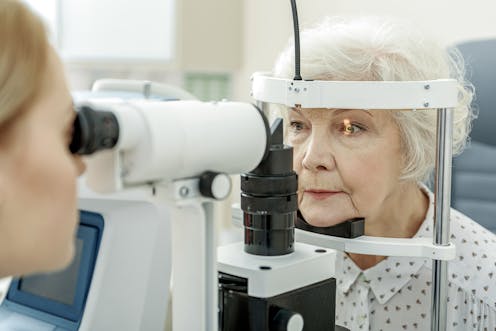
Many years ago, I began my PhD with the firm resolve of finding a cure for cataracts – not in several years or decades, but within the duration of my PhD. Such was my enthusiasm and naivety. Decades later, though, that dream looks as if it might come true.
Cataracts are the result of a buildup of broken protein fragments within the eye lens. This buildup and clumping together of protein fragments severely reduce the transmission of light to the retina – making things appear blurry or misty. It is the cause of around 43% of all blindness.
Surgery to remove the clouded lens and replace it with an artificial one has so far been the only treatment available for cataracts. About 10 million cataract operations are performed each year, globally. The procedure can be life-changing, but who would not want to avoid surgery if a less-invasive treatment was available? This is where sterol eye drops come into the picture. (Sterols are fat-like substances that occur in nature.)
My colleagues and I recently conducted a study in mice that showed promising and dramatic effects on cataracts after we applied a sterol compound to their eyes. When the compound was applied to one eye of 26 mice with cataracts, we found that 61% of the treated lenses showed an improvement in their refractive index gradient. This gradient is a measure of optical density and a vital component of image quality. The opacity of the lenses was reduced in 46% of the mice, as well.
However, the effects were not universal, suggesting that the same remedy may not apply to all cataracts (there are several types).
The compound we used had been tested before, but not for optics. Yet the optical quality of the lens is fundamental to light travelling unimpeded to the retina and hence to maintaining vision.
Investigations using this sterol compound reported in 2015 improved transparency in mouse lenses, and partially restored protein solubility both in the lenses of living mice and in human lenses in a dish.
But a subsequent study in 2019 could not find evidence that this compound reverses protein buildup in rat and human samples, nor that it reverses the opacities in rat lenses with cataracts. However, the sterol compound had not been tested on whole, intact human lenses. And most importantly, the effect of this compound on the optical property of the refractive index (that is, the optical quality of the lens) had not been measured.
Measuring optical quality
I have spent years developing and applying methods of measuring the optical quality of the lens, and have been measuring lens optics for over a decade using the most advanced system in the world, the SPring-8 synchrotron in Japan – a particle accelerator that produces powerful X-rays, allowing measurements to be taken with the highest accuracy yet on optical properties of the eye.
This technology has allowed my colleagues and me to accurately characterise the refractive index gradient in transparent lenses as well as those that have cataracts – something that could not be conducted using a visible light source.
The refractive index gradient is important for image quality because it provides improved focusing capacity. Cataracts disrupt this gradient because of the protein buildup. The application of X-ray measurements has been key to our latest findings. In addition, when we measure optical properties, we do this on whole lenses with the protein distributions left undisturbed in the lens.
The link between a lens’s optical function and the protein solubility and propensity to clump needs to be studied further. This is important for addressing whether it is possible to reverse the process of cataract formation and restore transparency to a clouded lens.
Scientists have long believed that a buildup of the major structural proteins of a cataract – the crystallins – is irreversible. So any possible treatment for a cataract could, at best, halt or slow its progression.
If this is not true and protein aggregation is reversible, then it opens up a wealth of treatment possibilities. Not only can cataracts be prevented by avoiding certain known causes, such as poor nutrition, smoking and certain drugs, such as steroids, it may be possible to use drugs that prevent further progression. Other drugs may even be able to reverse the process of cataract formation and restore clarity to a lens that has become clouded.
Further research needs to include investigations of all proteins in the lens: the major structural proteins of the lens (the crystallins and the water channel proteins) in tandem with studies of optical function.
We are currently looking at the optics of the lens from all aspects, from early developmental stages to adulthood, and looking at how these results map on to changes in proteins.
A great deal more research may be needed, but what our recent research findings have shown is that non-surgical treatment for cataracts is possible – and may be closer than we think.
Barbara Pierscionek currently receives funding from EU under the Marie Skłodowska-Curie Doctoral Training Centre scheme.
This article was originally published on The Conversation. Read the original article.







